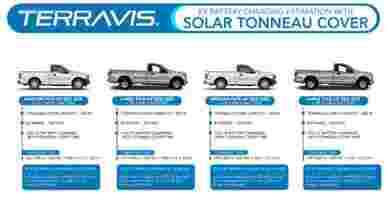This company wants to make your truck solar-powered
Did you know SHIFT is taking the stage on Sept 30 and Oct 1 ? Together with an amazing line-up of experts, we will explore the future of mobility during TNW Conference 2021. Secure your ticket now!

One day, all trucks will be electric. But it won’t be soon. Still, they still struggle with a number of big-ass painpoints: cost, range anxiety , and the need for charging infrastructure.
But what if there was a way to not have to worry about charging your pickup truck on a sunny day? The solution just might be solar.
Don’t get too excited, no one’s offering a fully functional solar truck. Yet
This week, Worksport opened up advance orders for a solar charging truck bed cover (or tonneau) called TerraVis. The solar integrated tonneau collects the sun’s rays and stores them in a high-capacity battery pack called the COR mobile Energy Storage.
Off-grid power becomes a reality
Stored energy is accessible via a built-in AC/DC inverter, ultimately extending the electric vehicle range as it drives. It can also be removed and used remotely. This makes off-grid power a reality.
I spoke to CEO Steven Rossi, who explained:
Worksport can retrofit your truck into a mobile microgrids


According to Rossi, a key feature to the system is Worksport’s “hot-swap” technology: this allows depleted batteries to be changed out within a 60-second window while the system remains in full use. You can remove and replace an almost depleted COR battery with a fully charged one without having the power cut off. Ross asserts:
The TerraVis can generate up to 1,000W of power and the portable battery bank can house up to 1,500W in total.
Beyond range extension
Besides charging vehicles, the TerraVis also has capabilities to provide power on worksites, camping trips, and in the case of natural disasters and medical emergencies. Rossi notes, “Imagine a mobile outdoor blood bank where the power has suddenly gone out. We can help with that.”
It’s also easy to predict interest from the military for use in desert terrain.
The company is partnering with EV truck companies Hercules and Atlis to configure the TerraVis system for their pickup trucks.
TerraVis Energy Systems is also engaged in innovating and designing high-efficiency, affordable Hydrogen Fuel Cells to fast charge Battery Electric Vehicles. The company is currently collaborating with Ontario Tech University as part of a two-year, $2.3 million project funded equally by Workspot and the Canadian Government.
Ok, so you won’t be running your pickup truck on solar for a long-distance trip just yet. 30km is not that far for someone who uses a pickup truck in a delivery role. Further, you need plenty of sun, which is not available all year for most of us. So you are paying for something you can’t get the full benefit from all of the time. That’s a downside.
But Worksport’s found a way to neatly sidestep the design challenges that have plagued solar-changing cars by focusing on the tonneau. Even better, their portable solution offers the entire pick-up truck industry a substantial step towards carbon neutrality and renewable energy use.
Further, they’ve crafted a way to test emerging green energy solutions on the customers who already use their truckbed tonneaus, but also build a customer base for future technology. That’s pretty smart.
Do EVs excite your electrons? Do ebikes get your wheels spinning? Do self-driving cars get you all charged up?
Then you need the weekly SHIFT newsletter in your life. Click here to sign up.
The real environmental impact of EVs and ICEs explained
Well, it’s a no brainer: EVs are good for the environment and ICEs are bad. It’s as simple as that.

Yet, there are of course the electrification opposers, flaunting as an argument that electric vehicles aren’t actually “zero-emission.”
Okay, I’ll give them that, no vehicle is 100% green , and there are indeed greenhouse emissions in the life-cycle of EVs.
But even when you take that into account, EVs are still ‘good’ for the environment, while fossil fuel cars are absolutely horrible. Just feast your eyes on this!


The image above is a comparative graph from the International Energy Agency detailing how much ICE vehicles suck, and EVs rule. But let’s brake it down.
We have three categories of vehicles:
The stinky ICEs, i fossil fuel fiends
The Base case BEVs, with lower CO2 emissions generated by their battery minerals (35kg per kilowatt hour)
The High GHG minerals case BEVs, with higher CO2 emissions generated by their battery minerals (70kg per kilowatt hour)
On the vertical axis we see the tons of CO2 emissions ( tCO₂e ) per vehicle lifetime, and the different colors represent different vehicle life-cycles.
Looking at this graph, one thing becomes instantly clear: ICEs have way higher greenhouse emissions.
During their manufacturing they emit 6 tCO₂e, and during their fuel cycle (from the production of fossil fuels to their use by the engine) they generate 35.9 tCO₂e. That makes a disturbing total of 49.9 tCO₂e per vehicle life-cycle.
Now the total for Base case BEVs reaches 19.7 tCO₂e , which is less than half of ICE lifetime emission. Similarly, High GHG minerals case BEVs emit 21.1 tCO₂e , which is also less than half .
Sure, BEVs might emit more during the manufacturing process than ICEs — 8 and 9.4 tCO₂e versus 6 tCO₂e — but the emissions they save by not burning fossil fuels completely negates that.
Gas-guzzlers pump out 35.9 tCO₂e using fossil fuels, while electricity consumption only has one third of those emissions, at 11.7 tCO₂e.
So, there you have it.
No matter how we approach this comparison, EVs are the clear winners. Yes , okay, they have higher emissions during their production cycle, but how could this ever hide the fact that they emit HALF the CO2 amount of ICEs?
I rest my case.
Do EVs excite your electrons? Do ebikes get your wheels spinning? Do self-driving cars get you all charged up?
Then you need the weekly SHIFT newsletter in your life. Click here to sign up .
The UK’s appetite for EVs nearly doubled in 2021
The UK car industry might have been hit hard during the pandemic, but fortunately, there’s a bright spark : new EV registrations nearly doubled in 2021, according to the Society of Motor Manufacturers and Traders (SMMT).

This is a rare bit of good news for the auto world.
In its annual sales snapshot , SMMT reported that the ongoing pandemic — in combination with the semiconductor chip shortage — continued to have a negative impact on the UK’s car industry.
Specifically, 2021 new car registrations grew by a minimal 1.0% compared to 2020, as 1.65 million new vehicles entered the UK market.
This number is down a whopping 28.7% from pre-pandemic 2019 , representing the industry’s second worst year since 1992 (which had 1.594 million new car registrations).
Despite the doom and gloom, we can at least suckle on a bit of positivity: 2021 was the most successful year in history for electric vehicles!
Some 190,727 new EVs joined Britain’s roads, up 73.6% compared to 2020. This means that the EV market share has nearly doubled year-over-year from 6.6% to 11.6%.
Notably, in December 2021 alone, electric cars made up 26% of sales, representing one out of four new vehicles sold.
Things seem to be going in the right direction.
Automakers’ investments look like they’re paying off. On top of this, the UK is working towards its net zero plan, this includes the ban of new petrol vehicle sales in 2030 and various charging infrastructure initiatives, such as preset charging times and mandatory chargers in new buildings .
However, the number of public charging stations is still unevenly distributed , the Department for Transport has delayed the installation of chargers in commercial car parks , and the government has cut the EV grant twice the past year.
This is a confusing message. If the UK wants to achieve its net zero ambition, it needs to embrace clarity and go all in on electric vehicles.